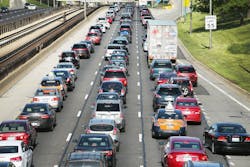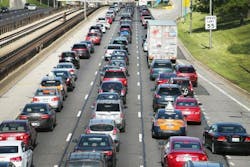Unlocking the mysteries of the random traffic jam
Have you ever seen a 2-mile long traffic jam on the opposite side of the highway and thought, “Gee, I didn’t see an accident back there, I wonder what happened?”
Or maybe you are cruising along at 60 mph and suddenly you slow to a stop. You then sit stationary for 30 seconds and just as quickly you are back to cruising at 60. What happened?
As it turns out, perhaps nothing. Researchers from five different universities, working under grants from the National Science Foundation, have studied the phenomenon of “phantom traffic jams” and come up with some conclusions. The most notable conclusion, though, is that a single car braking unexpectedly can cause a chain-reaction, called a “wave,” that generates the traffic jam.
“A chain of equidistant vehicles that move all with the same velocity will not remain in this nice configuration. Instead, a small perturbation grows, and builds up to become a wave of high vehicle density,” the researchers wrote.
This occurs even without any obvious reasons, the researchers noted. In essence, a slight slowdown of vehicles for any reason – a sharp curve, three lanes merging into two, even just a person who might be slightly distracted as they fumble with the radio and then hit the brakes as they close too quickly on the vehicle in front as a result – can cause a wave that generates a traffic jam.
The researchers have even given the phenomenon a name – a jamiton.
“While one jamiton does not delay the travel time of individual vehicles significantly (vehicles travel through a jamiton rather quickly), the sharp jump in vehicle density is a potential hot spot for accidents,” the study noted. “In addition, the results indicate that jamitons rarely stay alone. In practice, whole trains of jamitons can be expected in long stretches of heavy traffic, resulting in significantly increased fuel consumption, driver aggravation, wear and tear on materials, and risk for accidents.”
In other words, a jamiton can be costly.
To illustrate their work, the researchers referenced previous work that included a traffic circle and 22 vehicles, all placed equal distance from each other and all traveling (or supposedly doing so) at the same speed. You can see the results:
What the researchers concluded is that “phantom traffic jams are not necessarily caused by individual drivers behaving in a ‘wrong’ way. In fact, they can even occur if all drivers behave by the exact same laws.”
The researchers noted that a variety of factors come into play in creating jamitons, including road capacities, speed limits and driving behavior, which includes the fact that reaction times are not the same for everyone.
This research could lead to improved road design, but one of the possible answers to solving this problem is “electronic driving assistance hardware,” i.e. lane-departure warning and adaptive braking systems among other technologies.
But for now, it’s good to know that there really is no good reason for the 2-mile traffic jam I will probably sit in this afternoon on my way home from work.
The researchers involved in the study were:
- Morris R. Flynn (University of Alberta)
- Aslan R. Kasimov (KAUST)
- Jean-Christophe Nave (McGill University)
- Rodolfo Ruben Rosales (MIT)
- Benjamin Seibold (Temple University)

